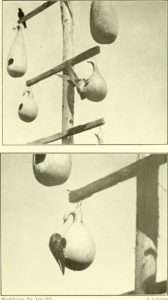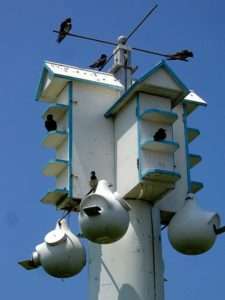 I recently got to see my very first purple martin (Progne subis) while leading a guided hike for the Friends of Willapa National Wildlife Refuge. As we walked along the Parker Slough trail in the evening light, a lone male purple martin perched on top of a post of nest boxes. He was content to stay there even as we passed, giving us an excellent opportunity to observe him.
I recently got to see my very first purple martin (Progne subis) while leading a guided hike for the Friends of Willapa National Wildlife Refuge. As we walked along the Parker Slough trail in the evening light, a lone male purple martin perched on top of a post of nest boxes. He was content to stay there even as we passed, giving us an excellent opportunity to observe him.
These birds get their name from their gorgeous, iridescent plumage. Adult males are completely dark with a mix of blue, black, and deep purple hues, while adult females and immature birds have substantial amounts of white, gray, and brown underneath, and primarily have blue/purple on their heads and backs. They’re the largest swallows in North America and have the typical forked tail of the family.
Purple martins breed in North America, but many of them make an incredible migration to South America for the winter, flying thousands of miles in fall and returning here in spring. Unfortunately, changes here have been giving the purple martin the summertime blues.
Where’s a Purple Martin to Live?
Humans have been providing the purple martin living space for centuries. Originally cavity-nesters who raised their young in holes in dead trees and similar spaces, they took to hollowed-out gourds and other artificial nest boxes that were provided by indigenous Americans, and later immigrants. Until recently, they would make use of both natural and artificial nesting sites as they were available.
That’s changed in the past couple of centuries as we’ve proceeded to destroy countless acres of forests, leading to the loss of dead trees and other natural nesting sites. As a result, while purple martins in the west are still using a mix of natural and artificial sites, those east of the Rockies are almost entirely dependent on humans for nesting sites.
 The challenge is that those gourds and other nest boxes need to be built and and then maintained long-term, often by volunteers. Not only does it take space, money and effort to build and place them, but they need to be monitored for intrusion by invasive species like house sparrows (Passer domesticus) and European starlings (Sturnus vulgaris). And the nest boxes also need repair or replacement as they fall prey to the elements over time.
The challenge is that those gourds and other nest boxes need to be built and and then maintained long-term, often by volunteers. Not only does it take space, money and effort to build and place them, but they need to be monitored for intrusion by invasive species like house sparrows (Passer domesticus) and European starlings (Sturnus vulgaris). And the nest boxes also need repair or replacement as they fall prey to the elements over time.
Adding to the challenge is the fact that many of the people who are tending to purple martin nest boxes are older, and as they pass away no one is stepping up to take their place. Given that rising housing prices far out of proportion with average wages are contributing to fewer younger people owning homes with yards, even those who may want to be up and coming purple martin landlords may not have a property on which to establish nest boxes. The potential loss of one species of synanthropic bird–one that is closely related to humans–seems a sad side effect of this economic reality.
Be a Purple Martin Guardian!
Being a good steward to your local birds is an incredibly rewarding activity. For those who are willing and able to be the caretaker for purple martin nest boxes, there are plenty of resources available. Even if you don’t have property, you might see about volunteering to help take care of an existing set of nest boxes. Many wildlife refuges, parks, and other public lands have them in place, and some private citizens may appreciate an extra hand in caretaking the boxes. In fact, there’s a Facebook group where you can chat with other purple martin landlords and wannabes. That may be a good starting place to ask about how to help with established purple martin nest sites.
If you will be maintaining nest boxes on your property, your first step is to make sure purple martins actually breed in your area (an email to your local branch of the Audubon Society may be helpful here.) Even if you’re west of the Rockies where these birds may still use natural nesting sites, it can’t hurt to give them a few more options.

Then determine if your property has a good spot for a nesting site. The Purple Martin Conservation Association–itself an incredible wealth of information on attracting and tending to these birds–has a nice writeup of the best locations here. Then you’ll need to invest in some nest boxes, whether the traditional gourds (real or plastic) or a multi-compartment house. Many are placed on a tall, telescoping pole or a pole with a winch system. Make sure that whatever your houses are built on that they have adequate baffling and blocks to keep predators like raccoons from climbing up the pole.
Keeping competitors out of the nest boxes is tough. Often the best thing to do is to wait a little later in the year to put the nest boxes out or open them up, as many of the other birds will nest earlier than the purple martins. If non-native species like starlings or house sparrows begin to try to nest in the boxes, you can remove them with impunity, as they are considered invasive; starlings in particular may attack and even kill purple martins. (In fact, the purple martin population crashed hard in the middle of the 20th century due to the explosion of starlings in North America, and by the 1980s there were almost no martins left.) Some purple martin nests have special openings that help keep starlings in particular from getting in.
Prospective purple martin landlords should not ignore the Migratory Bird Treaty Act that protects native birds, their nests and eggs; disturbing (or killing) them is a federal crime, and is additionally ecologically unsound as it can threaten local populations of native species. Do your best to prevent native species like bluebirds and wrens from getting into the nest boxes in the first place by blocking the entrances, and research when the purple martins typically return to your area so you don’t remove the barriers too early.
 Beyond that? It’s a waiting game. It may take a few years for the purple martins to discover your nesting boxes; purple martin enthusiasts often refer to people who have yet to have their first nesting pair as “wannabe landlords.” But this just means you’re not the only one waiting, and it will just make that first successful season that much sweeter!
Beyond that? It’s a waiting game. It may take a few years for the purple martins to discover your nesting boxes; purple martin enthusiasts often refer to people who have yet to have their first nesting pair as “wannabe landlords.” But this just means you’re not the only one waiting, and it will just make that first successful season that much sweeter!
Did you enjoy this post? Consider taking one of my online foraging and natural history classes, checking out my other articles, or picking up a paperback or ebook I’ve written! You can even buy me a coffee here!
